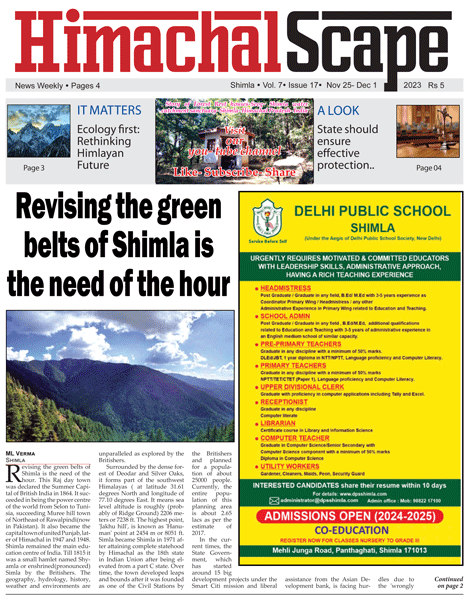Shimla Shiv baudi rain disaster: Committee reveals debris-blocked channe as key culprit
Shimla, Nov 28
An 8-member panel from the H.P. Council for Science, Technology, and Environment (HIMCOSTE) has released a report indicating oversaturation of rainwater and land subsidence due to the filling of debris in the drainage system. The committee, consisting of members such as Dr. S.S. Randhawa, Principal Scientific Officer at HIMCOSTE, Puneet Guleria, State Geologist from the Geological Wing of the Industry Department, and others, highlighted multiple reasons for the recent monsoon fury in the capital town.
Before concluding this technical report, the committee focused on the main disaster, Shiv Bauri, which claimed the lives of 21 people and disrupted the world heritage sites of Kalka and Shimla for three months.
Also read: Shimla monsoon disaster aftermath: Geological assessment ordered for vulnerable areas and Schools
This significant disaster occurred on August 14 around 7:30 am, stemming from the back side of the Indian Institute of Advanced Study (IIAS) and extending downstream to Shiv Bauri in the Summer Hill area.
According to the technical report, the total length of the slide is about 230 meters from IIAS to Shiv Bauri, further extending along the nala section. The slide was triggered by the failure of the thick overburden from IIAS, situated on the water divide, with no in-situ rock exposures visible along the slope. The bending of trees, resembling hockey blades, indicates that the region is characterized by debris cover.
The slope failure occurred due to oversaturation of the subsurface thick debris cover, resulting in a thick debris flow along the slope, uprooting large trees due to heavy precipitation.
At the midpoint of the slope along the Boileauganj Summer Hill road, in-situ schist forming part of the Jutogh Group is well exposed. The debris flow activated along a linear depression, and the section downstream of the road follows this depression, appearing to be a buried channel filled over time.
The debris flow caused the caving of the railway track and the collapse of the Shiv Bauri temple structure, burying 20 persons alive.
The panel’s recommendations include restoring the damaged part of the advanced studies campus by providing a retaining wall, restoring the railway track, removing muck and trees to protect existing roads, and examining cost drainage provisions.
The slide that originated from the IIAS campus damaged the temple along its path. The debris flow started from the IIAS campus, moving along the weak plane of the depression, an old buried channel of a dry stream that is highly fractured and structurally controlled, now filled up.
Locations like these are conduits for the infiltration of subsurface water in metamorphic terrains, as metamorphic rocks lack primary porosity, and infiltration occurs along fractures with secondary porosity. The region was highly oversaturated under such conditions, and with very heavy precipitation, the impact was substantial.
It is noteworthy that based on the panel’s recommendation, the state government included the Shiv Bauri region in the green belt and closed the emerged fault line as one of the eight new green zones. The notification is already in the advanced stage of the departmental process.
An interesting aspect of this major disaster is that, apart from the IIAS, which is about a hundred years old, and a few structures, two roads, a path, and a railway line are anthropogenic activities that precipitated this disaster, as indicated in the report.
Except for the Shiv temple and a couple of structures, no major human activities are observed in this belt, and the report does not establish any leakage of water from IIAS.
Empower Independent Journalism – Join Us Today!
Dear Reader,
We’re committed to unbiased, in-depth journalism that uncovers truth and gives voice to the unheard. To sustain our mission, we need your help. Your contribution, no matter the size, fuels our research, reporting, and impact.
Stand with us in preserving independent journalism’s integrity and transparency. Support free press, diverse perspectives, and informed democracy.
Click [here] to join and be part of this vital endeavour.
Thank you for valuing independent journalism.
Warmly,
Vishal Sarin, Editor








